The Ordovician is a geologic period and system, the second of six periods of the Paleozoic Era. The Ordovician spans 41.6 million years from the end of the Cambrian Period 485.4 million years ago (Mya) to the start of the Silurian Period 443.8 Mya.

The Silurian is a geologic period and system spanning 24.6 million years from the end of the Ordovician Period, at 443.8 million years ago (Mya), to the beginning of the Devonian Period, 419.2 Mya. The Silurian is the shortest period of the Paleozoic Era. As with other geologic periods, the rock beds that define the period's start and end are well identified, but the exact dates are uncertain by a few million years. The base of the Silurian is set at a series of major Ordovician–Silurian extinction events when up to 60% of marine genera were wiped out.

The rugosa, also called the tetracorallia or horn coral, are an extinct order of solitary and colonial corals that were abundant in Middle Ordovician to Late Permian seas.
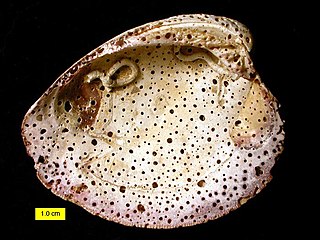
Bioerosion describes the breakdown of hard ocean substrates – and less often terrestrial substrates – by living organisms. Marine bioerosion can be caused by mollusks, polychaete worms, phoronids, sponges, crustaceans, echinoids, and fish; it can occur on coastlines, on coral reefs, and on ships; its mechanisms include biotic boring, drilling, rasping, and scraping. On dry land, bioerosion is typically performed by pioneer plants or plant-like organisms such as lichen, and mostly chemical or mechanical in nature.

Tabulata, commonly known as tabulate corals, are an order of extinct forms of coral. They are almost always colonial, forming colonies of individual hexagonal cells known as corallites defined by a skeleton of calcite, similar in appearance to a honeycomb. Adjacent cells are joined by small pores. Their distinguishing feature is their well-developed horizontal internal partitions (tabulae) within each cell, but reduced or absent vertical internal partitions. They are usually smaller than rugose corals, but vary considerably in shape, from flat to conical to spherical.

Stromatoporoidea is an extinct clade of sea sponges common in the fossil record from the Ordovician through the Devonian. They were especially abundant and important reef-formers in the Silurian and most of the Devonian. The group was previously thought to be related to the corals and placed in the phylum Cnidaria. They are now classified in the phylum Porifera, specifically the sclerosponges. There are numerous fossil forms with spherical, branching or encrusting skeletons of laminated calcite with vertical pillars between the laminae. Specimen of its oldest genus, Priscastroma, have been found within the Middle Ordovician Sediments. This same genus has been referred to as the species P. gemina Khrom., and is known to have been known to branch off into two forms, A and B. Form A gave rise to the genus Cystostroma while form B gave rise to the genus Labechia and its descendants. Paleozoic stromatoporoids died out at the Hangenberg Event at the end of the Devonian. Purported Mesozoic stromatoporoids may be unrelated, thus making "stromatoporoids" a polyphyletic group if they are included.
In the geological timescale, the Llandovery Epoch occurred at the beginning of the Silurian Period. The Llandoverian Epoch follows the massive Ordovician-Silurian extinction events, which led to a large decrease in biodiversity and an opening up of ecosystems.
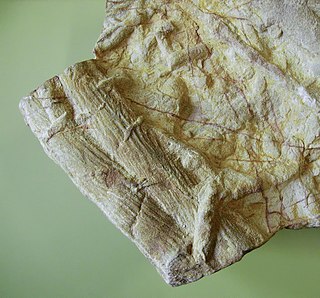
Cruziana is a trace fossil consisting of elongate, bilobed, approximately bilaterally symmetrical burrows, usually preserved along bedding planes, with a sculpture of repeated striations that are mostly oblique to the long dimension. It is found in marine and freshwater sediments. It first appears in upper Fortunian rocks of northern Iran and northern Norway. Cruziana has been extensively studied because it has uses in biostratigraphy, and because the traces can reveal many aspects of their makers' behavior.

Carbonate hardgrounds are surfaces of synsedimentarily cemented carbonate layers that have been exposed on the seafloor. A hardground is essentially, then, a lithified seafloor. Ancient hardgrounds are found in limestone sequences and distinguished from later-lithified sediments by evidence of exposure to normal marine waters. This evidence can consist of encrusting marine organisms, borings of organisms produced through bioerosion, early marine calcite cements, or extensive surfaces mineralized by iron oxides or calcium phosphates. Modern hardgrounds are usually detected by sounding in shallow water or through remote sensing techniques like side-scan sonar.

Trypanites is a narrow, cylindrical, unbranched boring which is one of the most common trace fossils in hard substrates such as rocks, carbonate hardgrounds and shells. It appears first in the Lower Cambrian, was very prominent in the Ordovician Bioerosion Revolution, and is still commonly formed today. Trypanites is almost always found in calcareous substrates, most likely because the excavating organism used an acid or other chemical agent to dissolve the calcium carbonate. Trypanites is common in the Ordovician and Silurian hardgrounds of Baltica.

Cornulitida is an extinct order of encrusting animals from class Tentaculita, which were common around the globe in the Ordovician to Devonian oceans, and survived until the Carboniferous.
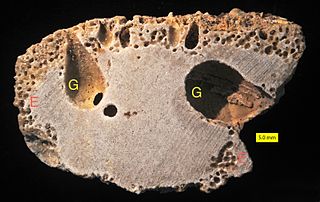
Gastrochaenolites is a trace fossil formed as a clavate (club-shaped) boring in a hard substrate such as a shell, rock or carbonate hardground. The aperture of the boring is narrower than the main chamber and may be circular, oval, or dumb-bell shaped. Gastrochaenolites is most commonly attributed to bioeroding bivalves such as Lithophaga and Gastrochaena. The fossil ranges from the Ordovician to the Recent. The first Lower Jurassic Gastrochaenolites ichnospecies is Gastrochaenolites messisbugi Bassi, Posenato, Nebelsick, 2017. This is the first record of boreholes and their producers in one of the larger bivalves of the globally occurring Lithiotis fauna which is a unique facies in the Lower Jurassic Tethys and Panthalassa.

The order Microconchida is a group of small, spirally-coiled, encrusting fossil "worm" tubes from the class Tentaculita found from the Upper Ordovician to the Middle Jurassic (Bathonian) around the world. They have lamellar calcitic shells, usually with pseudopunctae or punctae and a bulb-like origin. Many were long misidentified as the polychaete annelid Spirorbis until studies of shell microstructure and formation showed significant differences. All pre-Cretaceous "Spirorbis" fossils are now known to be microconchids. Their classification at the phylum level is still debated. Most likely they are some form of lophophorate, a group which includes phoronids, bryozoans and brachiopods. Microconchids may be closely related to the other encrusting tentaculitoid tubeworms, such as Anticalyptraea, trypanoporids and cornulitids.

Anticalyptraea is a fossil genus of encrusting tentaculitoid tubeworms from the Silurian to Devonian of Europe and North America . Anticalyptraea commonly encrust various invertebrate fossils such as stromatoporoids, rugose corals, bryozoans, brachiopods and crinoids, but they can also be common on the hardgrounds.

Osprioneides is an ichnogenus of unbranched, elongate borings in lithic substrate with oval cross−section, single−entrance and straight, curved or irregular course. Osprioneides kampto Beuck and Wisshak, 2008 is the largest known Palaeozoic boring trace. It occurs in the Ordovician and Silurian (Wenlock) of Baltica. The borings are up to 120 mm long measuring 5–17 mm in diameter. The distribution of Osprioneides is more environmentally limited than that of Trypanites in the Silurian of Saaremaa, Estonia (Baltica). Osprioneides probably occurred only in large hard substrates of relatively deepwater muddy bottom open shelf environments. Osprioneides were relatively rare, as compared to Trypanites-Palaeosabella borings in the Wenlock of Saaremaa.

Cornulites is a genus of cornulitid tubeworms. Their shells have vesicular wall structure, and are both externally and internally annulated. They usually occur as encrusters on various shelly fossils. Their fossils are known from the Middle Ordovician to the Carboniferous.
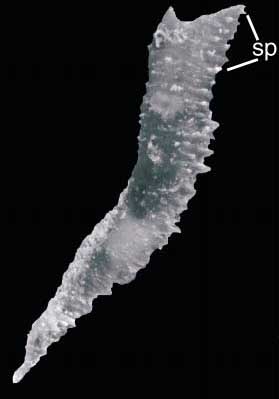
Conchicolites is a fossil genus of cornulitid tubeworms. Their shells lack vesicular wall structure and have a smooth lumen. They are externally covered with transverse ridges. Some species have spines. They usually occur as encrusters on various shelly fossils. Their fossils are known from the Late Ordovician to the Devonian.
Anoigmaichnus is an ichnogenus of bioclaustrations. Anoigmaichnus includes shafts perpendicular to their hosts' growth surfaces or tilted (up to 45°); conical to cylindrical; circular to oval cross-sections; lacking separate wall. Their apertures are elevated above their hosts' growth surfaces, forming short chimney-like structures. Anoigmaichnus is the world's earliest known macroscopic endobiotic symbiont and it may have been a parasite. It occurs in the Middle Ordovician bryozoans of Osmussaar Island, Estonia.
Burrinjuckia is an ichnogenus of bioclaustrations. Burrinjuckia includes outgrowths of the brachiopod's secondary shell with a hollow interior in the mantle cavity of a brachiopod. Burrinjuckia was probably a parasite. They have a stratigraphic range from the Late Ordovician to the Devonian. The earliest Burrinjuckia species B. clitambonitofilia Vinn, Wilson and Toom, 2014 occurs in brachiopod Clitambonites squamatus from the Late Ordovician oilshale of Estonia.
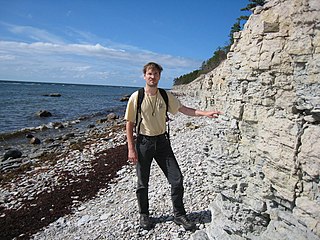
Olev Vinn is Estonian paleobiologist and paleontologist.

















